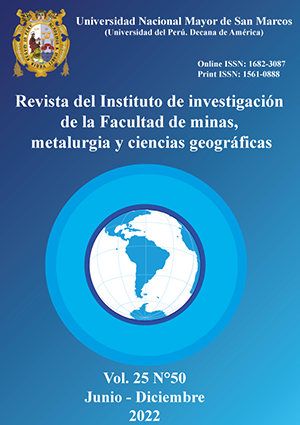Analysis of the mineralogical characterization of copper porphyries as a support for flotation processes
DOI:
https://doi.org/10.15381/iigeo.v25i50.24259Keywords:
copper, flotation, mineralogy, microscopy, recoveryAbstract
The mining industry of porphyry copper deposits process complex and low-grade minerals (Romero Toledo et al., 2017). One of the problems related to this practice, is the type of mineral, harming the mining - metallurgical treatment that affects the consumption of excessive energy and the critical recovery of economic minerals (Mudd, 2010). The objective of the research was to analyze the mineralogical characterization; then to contrast the behavior of the minerals in the process of flotation of minerals in the porphyry deposits of copper and with it to implement improvements (Díaz Villena, 2017).
The techniques used were X-ray diffraction, optical-electronic microscopy (Manzaneda Cabala, 2010) and chemical analysis. They provided reliability and support to determine qualitatively and quantitatively the mineral phases that cause problems in the flotation of copper minerals (Donoso Droguett, 2020). The main conclusion is that mineralogical characterization encompasses activities that utilize a better understanding of the properties of the ore and residues, which impact positively or negatively on the value of the product.
Downloads
Published
Issue
Section
License
Copyright (c) 2022 Guillermo Kenneth Iriarte Dávila, Madeleine Guillen Gómez, Edmundo Abdul Alfaro Delgado

This work is licensed under a Creative Commons Attribution 4.0 International License.
AUTHORS RETAIN THEIR RIGHTS:
a. Authors retain their trade mark rights and patent, and also on any process or procedure described in the article.
b. Authors retain their right to share, copy, distribute, perform and publicly communicate their article (eg, to place their article in an institutional repository or publish it in a book), with an acknowledgment of its initial publication in the Rev. Inst. investig. Fac. minas metal cienc. geogr.
c. Authors retain theirs right to make a subsequent publication of their work, to use the article or any part thereof (eg a compilation of his papers, lecture notes, thesis, or a book), always indicating the source of publication (the originator of the work, journal, volume, number and date).






